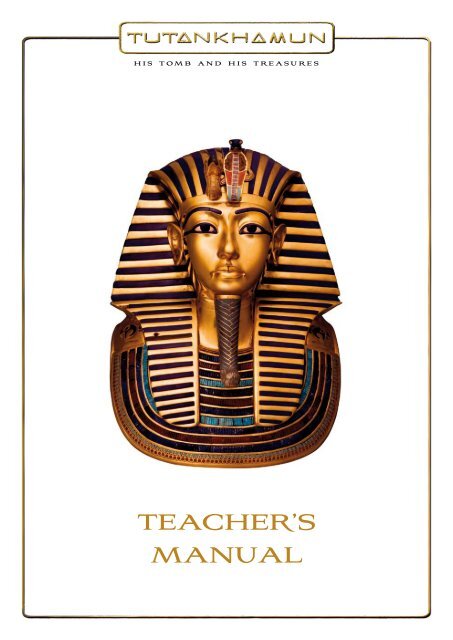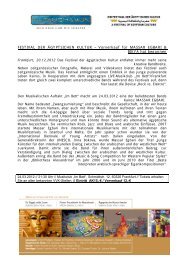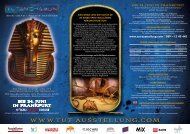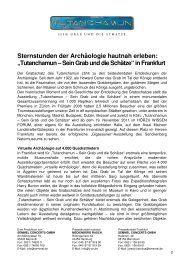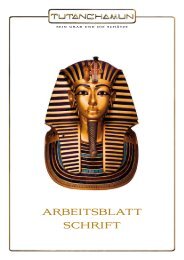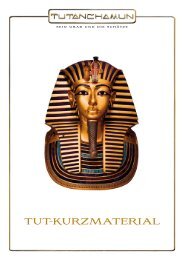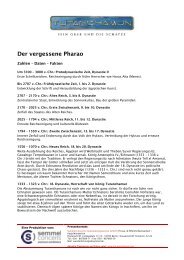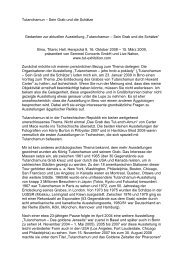Teacher's manual (PDF)
Teacher's manual (PDF)
Teacher's manual (PDF)
You also want an ePaper? Increase the reach of your titles
YUMPU automatically turns print PDFs into web optimized ePapers that Google loves.
1h i s t om b an d h i s t r e asu r e sTeacher’sManualDeveloped by Facts & Files Historisches Forschungsinstitut Berlin, www.factsandfiles.com for TUTANKHAMUN – HIS TOMB AND HIS TREASURES, © 2008Research Consultants: Susanne Martinssen-von Falck, M.A. and Dr. Wolfgang Wettengel
2h i s t om b an d h i s t r e asu r e s1. The TUT school materialThe target group for the TUT school material isten to twelve year-old schoolchildren. The topicof Ancient Egypt is dealt with in schools mostlyunder the heading of Ancient Civilisations. Thetopic of Tutankhamun and the Discovery of theTomb can thus also be integrated into ReligiousStudies and Geography.The school material is designed to accompany avisit to the exhibition ‚Tutankhamun – His Tomband His Treasures‘. It provides both preparatoryinformation for teachers and practical instructionsheets for schoolchildren. One requirement for usingthe school materials is an introductorylesson on the topic of Ancient Civilisations. Thematerial is designed for groups in a school class,which makes practical project work possible. Itpicks up on the following topics in the exhibition:1. Howard Carter‘s discovery /the adventure of archaeology2. Pharaohs, pyramids, world of the gods3. Mummies / tombs4. The NileThe school material also contains three tightlyplanned lessons, with one lesson scheduled forthe visit to the exhibition (TUT compact material).This also makes it possible for students to engagewith Tutankhamun outside the projects outlinedhere.The TUT compact material deals with the followingcontent:a) The discovery of Tutankhamun‘s tombb) Pharaohs and the world of the godsThe following presents the topic and the maincontents of the exhibition.5. WritingThese topics can be worked on by five projectgroups in a school class and subsequentlybrought together in a joint presentation. Thesepresentations can, on the one hand, be a videodocumentary, a talking book, a newspaper or ashort play showing parts of Egyptian history, orthe students can put on „TUT festivals“ in whichthey give individual presentations.Developed by Facts & Files Historisches Forschungsinstitut Berlin, www.factsandfiles.com for TUTANKHAMUN – HIS TOMB AND HIS TREASURES, © 2008Research Consultants: Susanne Martinssen-von Falck, M.A. and Dr. Wolfgang Wettengel
3h i s t om b an d h i s t r e asu r e s2. The exhibition‚Tutankhamun – His Tomb and His Treasures‘The school material is designed to complementthe objects shown in the exhibition. All the piecesin the exhibition are exact, handmade copies oftreasures from Tutankhamun‘s tomb and are theresult of years of painstaking work by craftspeoplein Egypt. This has produced unique objects whichmake it possible to reconstruct the tomb as it wasfound when Howard Carter discovered it in 1922.The funerary equipment also allows many aspectsof Ancient Egyptian life and the rule of thepharaohs to be presented in a particularly vividway.View of the ritual beds in the antechamberAt the beginning of the exhibition visitors areintroduced to the topics of Ancient Egypt, The LandAlong the Nile and Discovery of the Tomb. A timescale opens the multimedia journey through timeto the 18th Dynasty. It establishes the historicalbackground and introduces the historical personalities.A short film about Howard Carter‘s and LordCarnarvon‘s search for Tutankhamun‘s tomb isthen shown, which ends with the discovery of thetomb.© Copyright Griffith Institutebackground is provided. Here the shrines of thetomb chamber, the sarcophagus and all threecoffins are presented first. This section of theexhibition takes the death cult and AncientEgyptians‘ conception of the afterlife as its themeand explains the funerary objects, as well as themummification process. A further high point isa display of the famous gold mask together withselected pieces of jewellery.Various statues of gods were placed in the tombwith the pharaoh to assist his resurrection in theafterlife. Exact copies of these figures are shownin a further module. The exhibition displays25 copies of ushabti figures which were to serveTutankhamun in the hereafter. His tomb alsocontained two small coffins with the mummiesof stillborn children.Next, objects such as the throne, sceptre andfans can be seen, which the pharaoh used assymbols of power on official occasions, alongwith various types of furniture that were also usedin daily life, as well as weapons, chariots andhunting implements. Utilitarian objects such astoy boxes, games, writing implements and musicalinstruments highlight other aspects of everydaylife.Three reconstructed tomb chambers can be seenafter the film. Unique to this exhibition is thearrangement of the funerary equipment, which thevisitor finds just as it was discovered by HowardCarter‘s excavation team. In the adjoining rooms,individual objects can be seen up close and informationon their history, purpose and religiousChariot© Copyright Griffith InstituteDeveloped by Facts & Files Historisches Forschungsinstitut Berlin, www.factsandfiles.com for TUTANKHAMUN – HIS TOMB AND HIS TREASURES, © 2008Research Consultants: Susanne Martinssen-von Falck, M.A. and Dr. Wolfgang Wettengel
4h i s t om b an d h i s t r e asu r e s3. Tutankhamun – pharaoh of the 18th DynastyAncient Egyptian sources make very little mentionof Pharaoh Tutankhamun. He only became known,indeed famous, on the spectacular discovery ofhis almost intact burial chambers by the British archaeologistHoward Carter in 1922. Tutankhamunruled Egypt during the New Kingdom period (18thto 20th Dynasty, around 1550 to 1070 B.C.). The18th Dynasty began with Ahmose, who ended thedomination of the ‘Hyksos’ over Egypt. The Hyksoswere a foreign people known for their horsemanshipwhose actual name and origin is unknown.Ahmose drove the Hyksos out of Egypt and hissuccessors reconquered further areas, such asNubia. Egypt became a world power and Thebes,today known as Luxor, became the residence of thepharaohs. Their empire stretched along the Nilefrom the Mediterranean to Nubia and extended asfar as Mesopotamia. The Valley of the Kings in thecity of the dead (necropolis) on the west bank ofMask of Tutankhamunthe Nile oppositeThebes becamethe burial placeof almost all thekings of the NewKingdom. The 18thDynasty was definitivelyshaped byfamous pharaohssuch as Hatshepsutwho immortaliseda foreigntrade expedition tothe incense land of Statue of Tutankhamun in woodPunt in her Thebanmortuary temple, the great commander TuthmosisIII, and Pharaoh Amenhotep III, who ruled in pompand splendour and was Tutankhamun’s grandfather.Unlike in the Old and Middle Kingdoms, thepharaohs of the New Kingdom were buried in tombchambers cut deep into the rock and no longer inpyramids. Monumental temple complexes nowarose in Thebes and Karnak which are still admiredtoday. Amun, the ‘hidden’ god, became the chiefdeity.The son of Amenhotep III, Pharaoh AmenhotepIV (1353-1336 B.C.), who called himself Akhenaten,brought in radical changes with his religiousrevolution. This period of rule is called the AmarnaPeriod, because Akhenaten and his consortNefertiti transferred their residence to Tell el-Amarna in Middle Egypt. The Pharaoh introduceda monotheistic faith and had the cults of all othergods radically suppressed, the old temples closed,and gods’ statues and inscriptions destroyed,especially those of the god Amun. Only Aten, theshining god of the sun disk, was allowed to beworshipped. While Akhenaten was seen as a greatinnovator in Carter’s day because of his worshipof a single god, Egyptologists nowadays see thefanatical downside of this pharaoh’s rule.Akhenaten’s reign triggered a serious crisis intraditionally-minded Egypt.© Copyright Griffith InstituteDeveloped by Facts & Files Historisches Forschungsinstitut Berlin, www.factsandfiles.com for TUTANKHAMUN – HIS TOMB AND HIS TREASURES, © 2008Research Consultants: Susanne Martinssen-von Falck, M.A. and Dr. Wolfgang Wettengel
5h i s t om b an d h i s t r e asu r e s3. Tutankhamun – pharaoh of the 18th DynastyAfter the death of Akhenaten, we know of twoother pharaohs who died early and thus only ruledbriefly, which meant that Tutankhamun becamepharaoh in 1332 B.C. at the age of about nine.This son of Akhenaten’s died at only 18 years old.The latest investigations on the mummy using CATscans seem to indicate a severe knee injury as thecause of death. DNA data have also detected otherillnesses the King suffered from.Tutankhamun’s achievements as a monarch areoften underestimated today. The country went backto its traditions under his rule. This restoration wasan important precondition for the renewed stabilityof the kingdom. Completely new religious ideasarose as a reaction to the Amarna catastrophe. Forinstance, one of the gilded shrines in the burialchamber bears an account similar to the Floodlegend, of how the sun god would have almostcompletely destroyed a sinful human race becauseit had turned away from the gods.Among the last pharaohs of the 18th Dynasty werethe high official Ay and General Horemheb.Under Horemheb and his successors many of themonuments and statues of the Amarna period weredestroyed, unfortunately including evidence ofTutankhamun. Old inscriptions of the god Amunwere restored. Statues of Tutankhamun wereFresko der südlichen Wand der Grabkammer. Tutanchamun,in der Mitte, links gefolgt vom Gott Anubis, erhält von derGöttin Hathor das Symbol für „Leben“.altered and usurped by Horemheb. Horemhebwas followed by General Ra-Messe, who mountedthe throne as Ramesses I and founded the 19thDynasty. His son Seti I erected further templebuildings to the god Amun, which his famous sonRamesses II carried on. Ramesses II fought seriousbattles against the Hittites, who attacked Egyptfrom Syria. His successors had to fight off otherattacks, among others from the ‘Peoples of the Sea’from the Mediterranean region.© Copyright Griffith InstituteDeveloped by Facts & Files Historisches Forschungsinstitut Berlin, www.factsandfiles.com for TUTANKHAMUN – HIS TOMB AND HIS TREASURES, © 2008Research Consultants: Susanne Martinssen-von Falck, M.A. and Dr. Wolfgang Wettengel
6h i s t om b an d h i s t r e asu r e s4. The discovery of the tombby Howard CarterWho was Howard Carter? He was born on 9th May1874 in Kensington, a district of London. He grewup outside the city of London in the countrysideof north Norfolk. His father Samuel worked as apainter. During his childhood Carter came intocontact with the rich and famous Amherst family,which possessed a large private collection ofEgyptian art. Lord Amherst was a keen supporterof the Egypt Exploration Fund, a British society forexploring Ancient Egypt founded in 1882, whichstill exists in London as the Egypt ExplorationSociety. When the Egypt Exploration Fund waslooking for a talented draughtsman, LordAmherst recommended the young Howard Carter.In September 1891, at the age of seventeen, Cartertravelled to Egypt for the first time on behalf ofthe Egypt Exploration Fund. The archaeologicalexpedition went to Beni Hasan in Middle Egypt,and the hill tombs of the governors of the 11th and12th Dynasties, where Carter, under direction ofthe Egyptologist Percy E. Newberry, was to recordthe wall paintings of the tomb chambers. Egypthad been living through a turbulent period in itshistory. In 1798, French troops under Napoleonconquered Egypt, which at the time was part ofthe Ottoman Empire. Napoleon began by employingexperts to scientifically investigate the AncientEgyptian sites.In 1799, during the building of fortifications inRosetta (Rashid in Arabic), the famous RosettaStone was found. The text on this important find,shown in replica at the beginning of the exhibition,is written in two languages: the upper parthas two Egyptian inscriptions (in Demotic scriptand in hieroglyphics) with the Greek translationunderneath. The decipherment of this Egyptiantext by Jean Francois Champollion some 20 yearslater laid the foundations for the beginning ofscientific Egyptology. In 1801 the British defeatedthe French army, which then had to withdraw. AfterGreat Britain had acquired all the shares in theHoward Carter during work on the burial chamberSuez Canal, opened in 1869, it occupied Egypt in1882. Nominally the Egyptian viceroy remainedsubject to the Ottomans until 1914. The politicalsituation was very unstable.Carter and his contemporaries were able to buildon the knowledge of the young science of Egyptology.In 1892 he gained practical experienceon the excavations of the Briton William FlindersPetrie Petrie at Tell el-Amarna, the capitalunder Akhenaten and Nefertiti. Flinders Petrie haddescribed the Stonehenge area when he was stilla young man and in Egypt had taken the measurementsof the Pyramids of Giza. He developed aspecial method for dating pottery fragments,which would make him the ‘father of modernarchaeology’.In 1893, Carter joined an undertaking of the Fundunder the Swiss Edouard Naville. The objective wasto excavate the mortuary temple of Hatshepsut atDeir el-Bahari in Western Thebes. The work went on© Copyright Griffith InstituteDeveloped by Facts & Files Historisches Forschungsinstitut Berlin, www.factsandfiles.com for TUTANKHAMUN – HIS TOMB AND HIS TREASURES, © 2008Research Consultants: Susanne Martinssen-von Falck, M.A. and Dr. Wolfgang Wettengel
7h i s t om b an d h i s t r e asu r e s4. The discovery of the tomb by Howard Carteruntil 1899. As head draughtsman, Howard Carterwas in charge of documenting the reliefs andinscriptions of the temple. During their work on thetemple the archaeologists found unknown intacttombs of priests and officials. Gaston Maspero, thenew head of the Antiquities Service, finally offeredCarter the post of Chief Inspector for Upper Egyptand Nubia. The Antiquities Service was under thedirection of French archaeologists and was responsiblefor allocating excavation permits andexpanding the collection of the Egyptian Museumin Cairo. On 1st January 1900 Howard Carter tookup his new post in Luxor (Thebes).From 1902, Carter extended his field of activitiesand accepted a commission from the Americanlawyer Theodore Davis to supervise his excavationwork in the Valley of the Kings. In 1903, Carterdiscovered the already plundered but well-preservedtomb of Pharaoh Tuthmosis IV, probablyTutankhamun’s great-grandfather. Next to it,the mummy of Hatshepsut was found in a tombchamber. In the autumn of 1904 the AntiquitiesService transferred Carter to Cairo as Chief Inspectorfor Lower Egypt. Soon afterwards he came intoconflict with French tourists in Saqqara and wastransferred for disciplinary reasons. In October1905 Carter resigned. He carried on working as adraughtsman for archaeological publications andalso worked as a tourist guide, as well as continuinghis employment for Theodore Davis.At about the same time, the British Lord Carnarvonwas staying in Egypt to recover from the effectsof a car accident. In part through the dowry of hiswife, who was a daughter of Baron Alfred deRothschild, Lord Carnarvon possessed a fortunewhich he was keen to invest in excavations. Hisstay led to his becoming interested in Egyptology,and in the autumn of 1907 he was granted anexcavation permit for Thebes. MeanwhileTheodore Davis’s excavation team in the Valleyof the Kings found a faience cup with the name ofTutankhamun, the first indication that a tomb ofthe pharaoh must exist in the Valley. EventuallyDavis also found a pit with embalming materialand the remains of a funeral celebration forTutankhamun, as well as fragments of gold foilwith more cartouches of the pharaoh.In 1914 Carnarvon took over Davis’s excavationpermit. The First World War interrupted the preparationsfor excavation, so it was only in autumn1917 that the excavation team began systematicallysearching for the tomb of Tutankhamun in theValley of the Kings.Carter had marked the places where the indicationsof Tutankhamun had been found on a mapand formed a triangular area out of them which hedivided into squares on the map. This meant hecould document every excavation that had takenplace and its finds. Carter searched in vain for fiveyears. When Lord Carnarvon was on the point ofgiving up, Carter’s powers of persuasion resultedin one last excavation season. When almost thewhole of the area had already been investigated,Steps to Tutankhamun‘s tomb© Copyright Griffith InstituteDeveloped by Facts & Files Historisches Forschungsinstitut Berlin, www.factsandfiles.com for TUTANKHAMUN – HIS TOMB AND HIS TREASURES, © 2008Research Consultants: Susanne Martinssen-von Falck, M.A. and Dr. Wolfgang Wettengel
8h i s t om b an d h i s t r e asu r e s4. The discovery of the tomb by Howard Carteronly the unexplored land by the ruins of ancientbuilders’ huts at the entrance to the tomb ofRamesses VI was left. On 4th November 1922,Howard Carter discovered some steps under theruins. He telegraphed Lord Carnarvon to comeover from England. On 26th November 1922,Carter opened the wall to the antechamber in thepresence of Carnarvon, his daughter Lady EvelynHerbert and Carter’s colleague Arthur Callender.Carnarvon asked Carter whether he could seeanything. Carter answered with the famous words:“Yes, wonderful things.” Soon the team was certainit had discovered the tomb of Tutankhamun. Thefirst article about the discovery of the tombappeared on 30th November in the English newspaperThe Times. The discovery was celebrated asa sensation in the media around the whole world.Howard Carter immediately put a team of highcalibreexperts together. The Metropolitan Museumof Art in New York sent over its best people. WithoutArthur Mace and the chemist Alfred Lucas, manyof the organic materials which needed immediateconservation would be lost today. Over 2,800 glassnegatives by the photographer Harry Burton serveus today as records of the original positions of the5,000 objects that were found in the tomb chambers.Sir Alan Gardiner was to work on the inscriptionsand James Harry Breasted to interpret the sealimpressions. The architect Arthur Callender and theEgyptologist Percy Newberry completed the team.The chambers were to be completely inventoriedand cleared. Once the antechamber was empty,Lord Carnarvon and Carter opened the wall to theburial chamber in the presence of AntiquitiesService representatives on 17th February 1923.Shortly afterwards, Carnarvon was bitten by amosquito and then cut the bite while shaving. Hedied on 5th April 1923 from a lung inflammationfollowing blood poisoning. His death led to a publicdebate about the ‘curse of the pharaoh’, whichclaimed that it was forbidden to disturb thepharaoh’s rest. The Antiquities Service now issuedthe excavation permit to Lady Carnarvon.The four shrines, built one inside the other, weredisassembled in the burial chamber. The innermostshrine contained a stone sarcophagus withthree coffins lying one inside the other. The innermostcoffin contained the mummy of Tutankhamunwith the famous gold mask. [Graphic for shrine andcoffin construction] The team hoisted the lid of thered quartzite sarcophagus on 12th February 1924.A day later Howard Carter protested against theinterference of the Antiquities Service in thescientific processing of Tutankhamun’s tomb.Behind the Egyptian actions lay political conflictswhich had been smouldering for some time.Britain had granted Egypt its independence in1922 and it had become a constitutional monarchy.The first Egyptian king was Fouad I. The PrimeMinister Saad Zaghul Pasha was pursuing nationalisticgoals in 1924 and attempting to combatBritish influence. The opened sarcophagus was tobe presented to the press on 13th February 1924.The Egyptian forbade the wives of Carter’s teamHoward Carter at the opening of the fourth inner shrine inthe burial chamber© Copyright Griffith InstituteDeveloped by Facts & Files Historisches Forschungsinstitut Berlin, www.factsandfiles.com for TUTANKHAMUN – HIS TOMB AND HIS TREASURES, © 2008Research Consultants: Susanne Martinssen-von Falck, M.A. and Dr. Wolfgang Wettengel
9h i s t om b an d h i s t r e asu r e s4. The discovery of the tomb by Howard Cartermembers from being present at the occasion.Carter showed no sympathy for this, formulatedhis public protest, had the sarcophagus closed andas it were went on strike. The Antiquities Servicethen withdrew Lady Carnarvon’s excavation permit.After the British Governor General of the Sudanwas murdered in Cairo in November 1924, thePrime Minister had to resign and the country’spolitics became somewhat more pro-British.Howard Carter was finally able to resume workin January 1925 and on 10th October 1925 heopened the first coffin. On 11th November 1925the team took the mask off Tutankhamun’s mummyand started on the autopsy.The rooms of the tomb complex were systematicallycleared until 1932, with the finds numberedexactly and conserved. The specialists listed over5,900 objects. Carter decided to draw up a scientificreport which would give a detailed descriptionof the discovery of the tomb with its objects. Butthis never happened. Only his popular sciencereport was published in three volumes from 1923to 1933. Under constant exposure to the artificiallight and the air of the tomb, Howard Carter’s stateof health visibly deteriorated. He was in Egyptagain and again until 1936, but then he returnedto England. On 2nd March 1939 Howard Carterdied of cancer. The numerous other importantdiscoveries the famous archaeologist made beforeTutankhamun are still little known to the widerpublic today.Developed by Facts & Files Historisches Forschungsinstitut Berlin, www.factsandfiles.com for TUTANKHAMUN – HIS TOMB AND HIS TREASURES, © 2008Research Consultants: Susanne Martinssen-von Falck, M.A. and Dr. Wolfgang Wettengel


